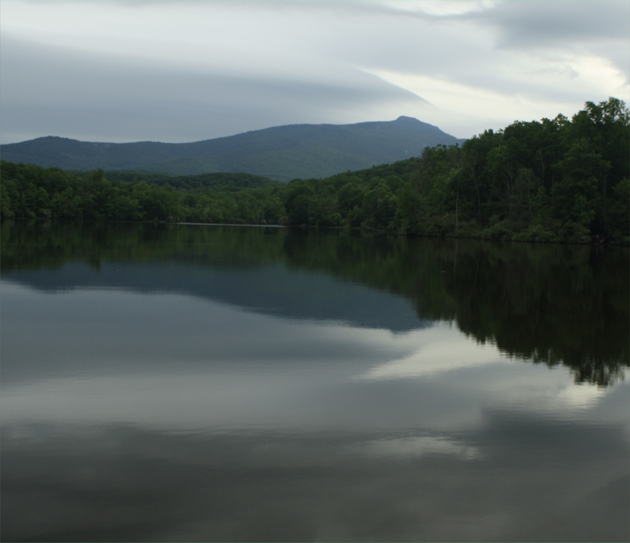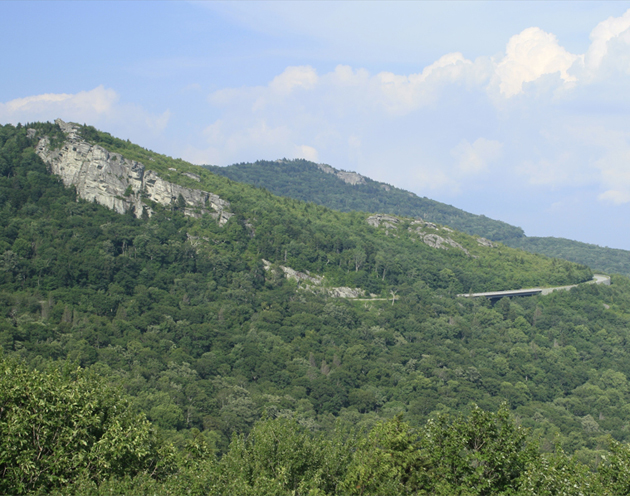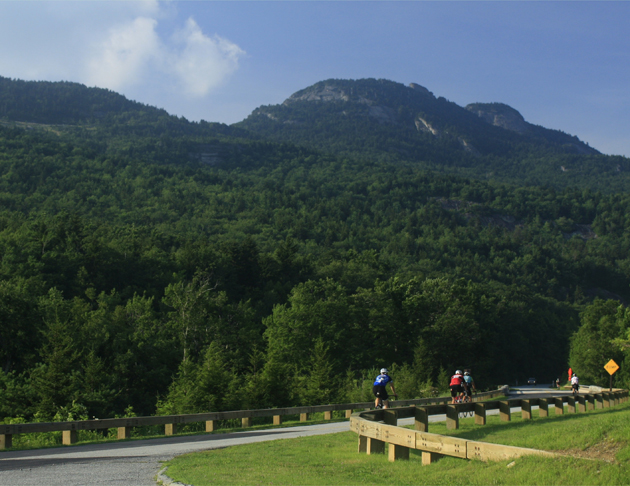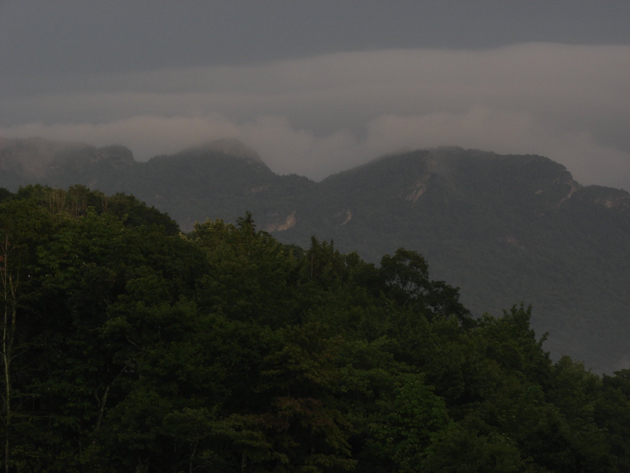Your Public Square Disclosing what is True, what is Real
Grandfather Mountain
Publisher's note: We believe the subject of history makes people (i.e., American people) smarter, so in our quest to educate others, we will provide excerpts from the North Carolina History Project, an online publication of the John Locke Foundation. This fifty-fifth installment, by Jonathan Martin, was originally posted in the North Carolina History Project.
The Blue Ridge Mountains have remained an iconic natural trait of North Carolina. The most prominent and the highest point on the mountain range is Grandfather Mountain, peaking at 5,964 feet. Grandfather Mountain rests in Avery County near the Caldwell and Watauga Counties.
The mountain-dwelling Cherokee tribe called the mountain "Tanawha," meaning a "fabulous bird" or "eagle." However, by the time the European explorers visited and explored the Blue Ridge Mountains, the mountain became known as "Grandfather Mountain;" after the shape of an old man's face in the cliff's profile. Today, the most popular vantage point to reveal the sleeping old man is the one at the town of Foscoe in Watauga County.

Looking southwest at Grandfather Mountain from the Julian Price Memorial Park: Above. Looking north at the Blue Ridge Parkway snaking along the eastern shoulder of Grandfather Mount: Below. photos by Stan Deatherage Click the picture to expand to as much as 1000 pixels wide within most expanded images, and then push the arrows embedded in the center edge of the play-box to access the gallery, and slide new images into viewing within the center of the screen.

Daniel Boone was one of the early hunter-explorers to climb the Grandfather Mountain in the 1760s, and Andre Michaux, a French scientist, ascended the peak in the fall of 1794. Upon reaching the top of Grandfather Mountain, Michaux wrote in his journal: "Reached the summit of the highest mountain in all of North America, and with my companion and guide, sang the Marseillaise and shouted 'Long live America and the Republic of France, long live liberty!'" (History of the Mountain). However, Michaux was wrong because Mt. Mitchell rises nearly a hundred feet taller than Grandfather at 6,684 feet.
Other important explorers that visited Grandfather Mountain include Asa Gray and John Muir. In 1841, Asa Gray found a species of flower that was named after him - Gray's Lily. Sierra Club founder John Muir climbed Grandfather Mountain in 1898. Muir experienced visual jubilee at the sights from Grandfather's peak.

Looking northeast at Grandfather Mountain from near the access point to Beacon Heights: Above. Looking west at the western facing ridge of Grandfather Mountain as the morning clouds gather to shroud the grandfathe looking sleeping giant resting on his inanimate back: Below. photos by Stan Deatherage Click the picture to expand to as much as 1000 pixels wide within most expanded images, and then push the arrows embedded in the center edge of the play-box to access the gallery, and slide new images into viewing within the center of the screen.

In 1885, Donald MacRae, a businessman from Wilmington, North Carolina, bought Grandfather Mountain and Linville Ridge from William W. Lenoir, grandson of Revolutionary War General William Lenoir. MacRae's son, Hugh MacRae, was commissioned to build a resort in the Linville area. After several years, MacRae had constructed North Carolina's first golf getaway and the Yonahlossee Road that connected Linville to the town of Blowing Rock (History of the Mountain).
Several decades later, Hugh M. Morton, Hugh MacRae's grandson, became the exclusive owner of the mountain. Morton made efforts to increase tourism, and in 1952, a 220-foot bridge was built at Grandfather's peak. Today, the bridge is known as the Mile High Swinging Bridge, and it remains Grandfather's primary tourist attraction.

Looking southwest at Grandfather Mountain, through often present clouds, from the Moses Cone Memorial Park: Above. Still looking southwest across Moses Cone Memorial park at Grandfather Mount: Below. photos by Stan Deatherage Click the picture to expand to as much as 1000 pixels wide within most expanded images, and then push the arrows embedded in the center edge of the play-box to access the gallery, and slide new images into viewing within the center of the screen.

Through the 1970s to the early 1990s, Morton organized several programs to enhance Grandfather's cultural value. In 1973, a habitat was constructed for specific animals in the Blue Ridge Mountains, and in 1989, the Nature Conservancy of N.C. and Morton sanctioned nearly 1,460 acres of mountain land for an animal and plant reserve. In addition, UNESCO (United Nations Educational, Scientific, and Cultural Organization) proscribed Grandfather Mountain as a specific Biosphere Reserve.
After the death of Hugh M. Morton in the summer of 2006, his family made additional efforts to conserve the Grandfather Mountain and its surrounding habitat. By 2009, the Grandfather Mountain Stewardship Foundation took control of the mountain's tourist duties, and the non-profit foundation continues to educate the public while seeking to preserve the region (History of the Mountain).
Two cultural events, Singing on the Mountain and the Grandfather Mountain Highland Games, draw tourists to the mountain each year. Singing on the Mountain, started in 1924, remains "one of the country's longest-running "old-time" gospel conventions" and it is held every summer at the base of Grandfather Mountain (Powell, p. 522). The Highland Games, organized in the late 1950s, centers on the age-old Scottish recreational games brought to the region by the Highland Scottish settlers. Today, the festival remains "one of the largest and most popular celebrations of Scottish heritage in the United States" (p. 522).
Sources:
"History of the Mountain." Grandfather Mountain website. http://www.grandfather.com/about-grandfather-mountain/history-of-the-mountain/, (accessed March 7, 2012).
"Grandfather Mountain." William S. Powell, ed. Encyclopedia of North Carolina (University of North Carolina Press: Chapel Hill, NC 2006).
Go Back
The Blue Ridge Mountains have remained an iconic natural trait of North Carolina. The most prominent and the highest point on the mountain range is Grandfather Mountain, peaking at 5,964 feet. Grandfather Mountain rests in Avery County near the Caldwell and Watauga Counties.
The mountain-dwelling Cherokee tribe called the mountain "Tanawha," meaning a "fabulous bird" or "eagle." However, by the time the European explorers visited and explored the Blue Ridge Mountains, the mountain became known as "Grandfather Mountain;" after the shape of an old man's face in the cliff's profile. Today, the most popular vantage point to reveal the sleeping old man is the one at the town of Foscoe in Watauga County.


Daniel Boone was one of the early hunter-explorers to climb the Grandfather Mountain in the 1760s, and Andre Michaux, a French scientist, ascended the peak in the fall of 1794. Upon reaching the top of Grandfather Mountain, Michaux wrote in his journal: "Reached the summit of the highest mountain in all of North America, and with my companion and guide, sang the Marseillaise and shouted 'Long live America and the Republic of France, long live liberty!'" (History of the Mountain). However, Michaux was wrong because Mt. Mitchell rises nearly a hundred feet taller than Grandfather at 6,684 feet.
Other important explorers that visited Grandfather Mountain include Asa Gray and John Muir. In 1841, Asa Gray found a species of flower that was named after him - Gray's Lily. Sierra Club founder John Muir climbed Grandfather Mountain in 1898. Muir experienced visual jubilee at the sights from Grandfather's peak.

In 1885, Donald MacRae, a businessman from Wilmington, North Carolina, bought Grandfather Mountain and Linville Ridge from William W. Lenoir, grandson of Revolutionary War General William Lenoir. MacRae's son, Hugh MacRae, was commissioned to build a resort in the Linville area. After several years, MacRae had constructed North Carolina's first golf getaway and the Yonahlossee Road that connected Linville to the town of Blowing Rock (History of the Mountain).
Several decades later, Hugh M. Morton, Hugh MacRae's grandson, became the exclusive owner of the mountain. Morton made efforts to increase tourism, and in 1952, a 220-foot bridge was built at Grandfather's peak. Today, the bridge is known as the Mile High Swinging Bridge, and it remains Grandfather's primary tourist attraction.


Through the 1970s to the early 1990s, Morton organized several programs to enhance Grandfather's cultural value. In 1973, a habitat was constructed for specific animals in the Blue Ridge Mountains, and in 1989, the Nature Conservancy of N.C. and Morton sanctioned nearly 1,460 acres of mountain land for an animal and plant reserve. In addition, UNESCO (United Nations Educational, Scientific, and Cultural Organization) proscribed Grandfather Mountain as a specific Biosphere Reserve.
After the death of Hugh M. Morton in the summer of 2006, his family made additional efforts to conserve the Grandfather Mountain and its surrounding habitat. By 2009, the Grandfather Mountain Stewardship Foundation took control of the mountain's tourist duties, and the non-profit foundation continues to educate the public while seeking to preserve the region (History of the Mountain).
Two cultural events, Singing on the Mountain and the Grandfather Mountain Highland Games, draw tourists to the mountain each year. Singing on the Mountain, started in 1924, remains "one of the country's longest-running "old-time" gospel conventions" and it is held every summer at the base of Grandfather Mountain (Powell, p. 522). The Highland Games, organized in the late 1950s, centers on the age-old Scottish recreational games brought to the region by the Highland Scottish settlers. Today, the festival remains "one of the largest and most popular celebrations of Scottish heritage in the United States" (p. 522).
Sources:
"History of the Mountain." Grandfather Mountain website. http://www.grandfather.com/about-grandfather-mountain/history-of-the-mountain/, (accessed March 7, 2012).
"Grandfather Mountain." William S. Powell, ed. Encyclopedia of North Carolina (University of North Carolina Press: Chapel Hill, NC 2006).
| Vidant Medical Center applies for Magnet status | NC Past, In the Past, Body & Soul | Transportation Priorities for North Carolina |





















